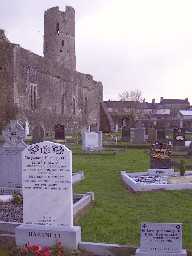 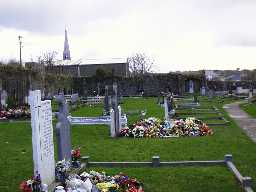
© SS Peter and Paul graveyard
There are several graveyards in the parish. At the old SS.
Peter & Paul church in Kilmallock, the church ground is still used
as a graveyard and it is the main graveyard in the parish.
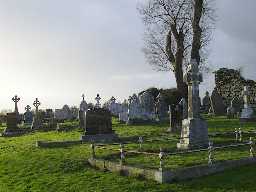
© Tankardstown graveyard
Tankardstown graveyard is on the site of a church ruin. The graveyard
is still in use and a local committee keeps the graveyard in good condition.
The oldest headstone that we came across was in memory of Mary Kennedy
who died on March 6th 1757, at the age of 75.
Also buried in the graveyard is one of the founders of the GAA, J. K.
Bracken from Ardvullen who died on May 2nd 1904. In 1984 Limerick GAA
erected a plaque to his memory. In the graveyard there is also a tree
that is believed to be 200-250 years old.

© GAA headstone
In Ardkilmartin graveyard there is also a church ruin. The
graveyard is still used for burials and there is a large headstone to
the Roche family. The oldest headstone that we found dates from 1704 and
was erected to Mary Giany who died aged 70. The month on the headstone
was indecipherable but the date was the 24th.
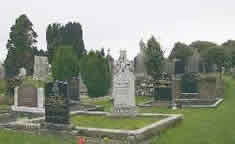
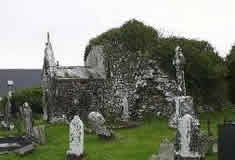
© Ballingaddy graveyard and a Tomb at back of Ballingaddy ruin
The graveyard in Ballingaddy is across the road from the church. In the
graveyard there is a church ruin. There are a number of tombs in the graveyard,
including a tomb to the Walsh family, dated 1846. The oldest headstone
that we came across was in memory of Fr Denis Hase who died on November
16th 1767, aged 62.
In "Echoes of Ballingaddy" Catherine O'Mahony mentions
the grave of John Flanagan in Ballingaddy graveyard. John Flanagan created
10 world records and won 3 Olympic Gold Medals in weight throwing. Mr.
Flanagan's grave is by the west wall of the graveyard.
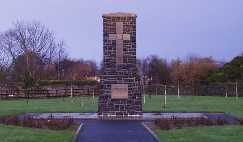
© Kilmallock Famine graveyard
In the parish there is a Famine graveyard. During the Great Famine of
1845-1849, Kilmallock was the site of a famine workhouse. It is believed
that up to 8,000 people were buried in the graveyard that died in either
the workhouse or in the town itself. However, the graveyard was used as
a burial place until around the 1920s for the poor of the area.
In June 1999, the President Mary McAleese opened the Famine Memorial
Park. A monument was unveiled to those who are buried here. The monument
is a large tower like structure with a cross and a plaque that gives the
details on the park. The sculpture was made from Kilkenny cut stone and
the park was grant aided by Ballyhoura Development Ltd. A number of trees
have been planted around the park.


|